Accounting Theory Report: AACo Financial Performance Analysis
VerifiedAdded on 2020/03/28
|14
|4286
|69
Report
AI Summary
This report provides a comprehensive analysis of the accounting theory applied by the Australian Agricultural Company (AACo), a company listed on the ASX. The executive summary highlights the importance of accounting policies and disclosures in assessing business performance. The report delves into AACo's major accounting policies, including those related to property, plant, and equipment (PPE), trade payables, borrowings, and inventories. It assesses the quality of accounting practices, identifying potential red flags in disclosure and examining the company's risk management strategies, particularly concerning liquidity, interest rate, credit, and foreign currency risks. Furthermore, the report explores the flexibility within AACo's accounting policies, especially regarding inventory valuation. The analysis also touches upon the conceptual framework and compliance aspects, reinforcing the company's foundation. The report concludes with an overview of the company's financial risk management and its approach to manage financial exposure. This detailed examination offers valuable insights into AACo's financial practices and their implications.
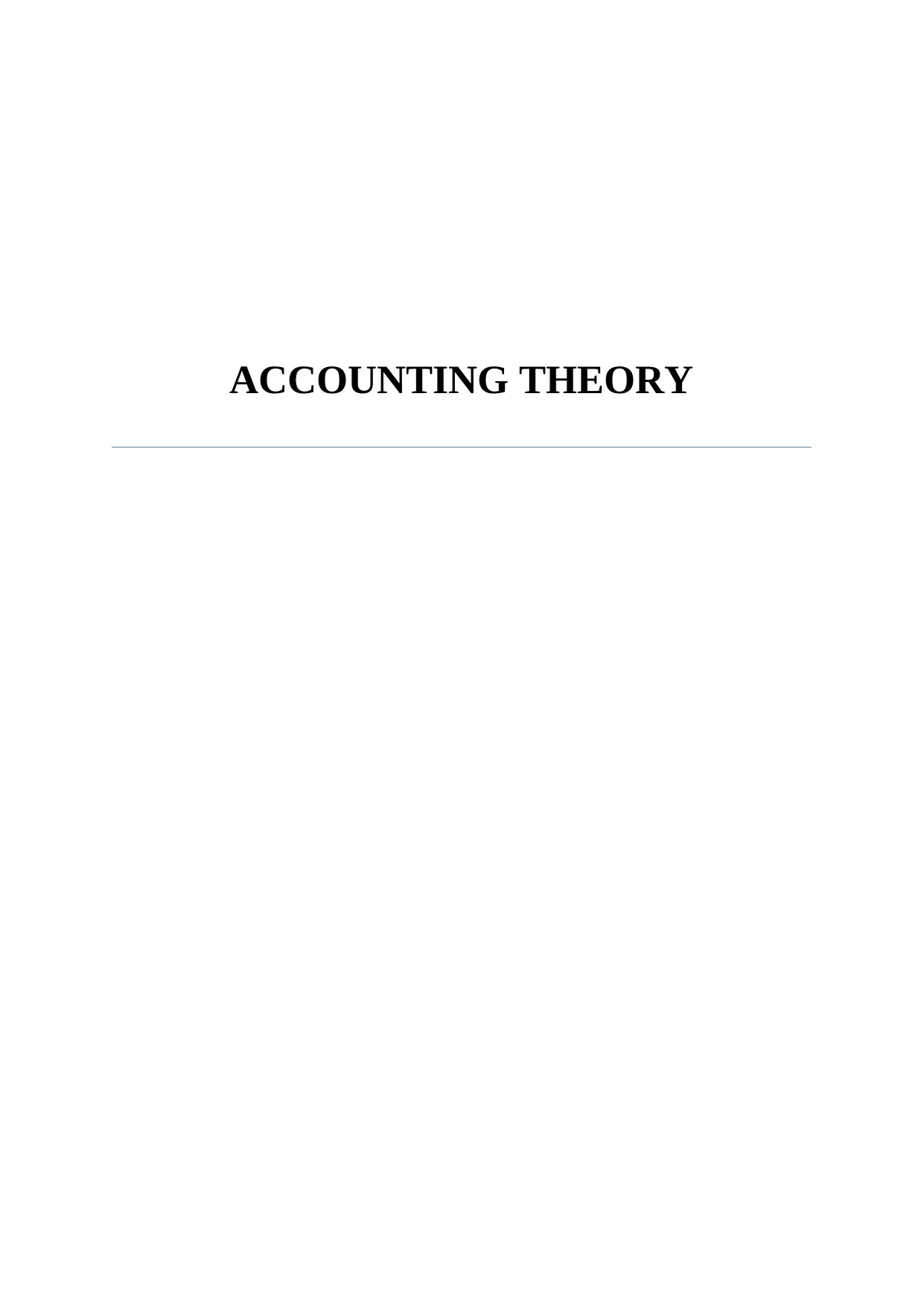
ACCOUNTING THEORY
Paraphrase This Document
Need a fresh take? Get an instant paraphrase of this document with our AI Paraphraser
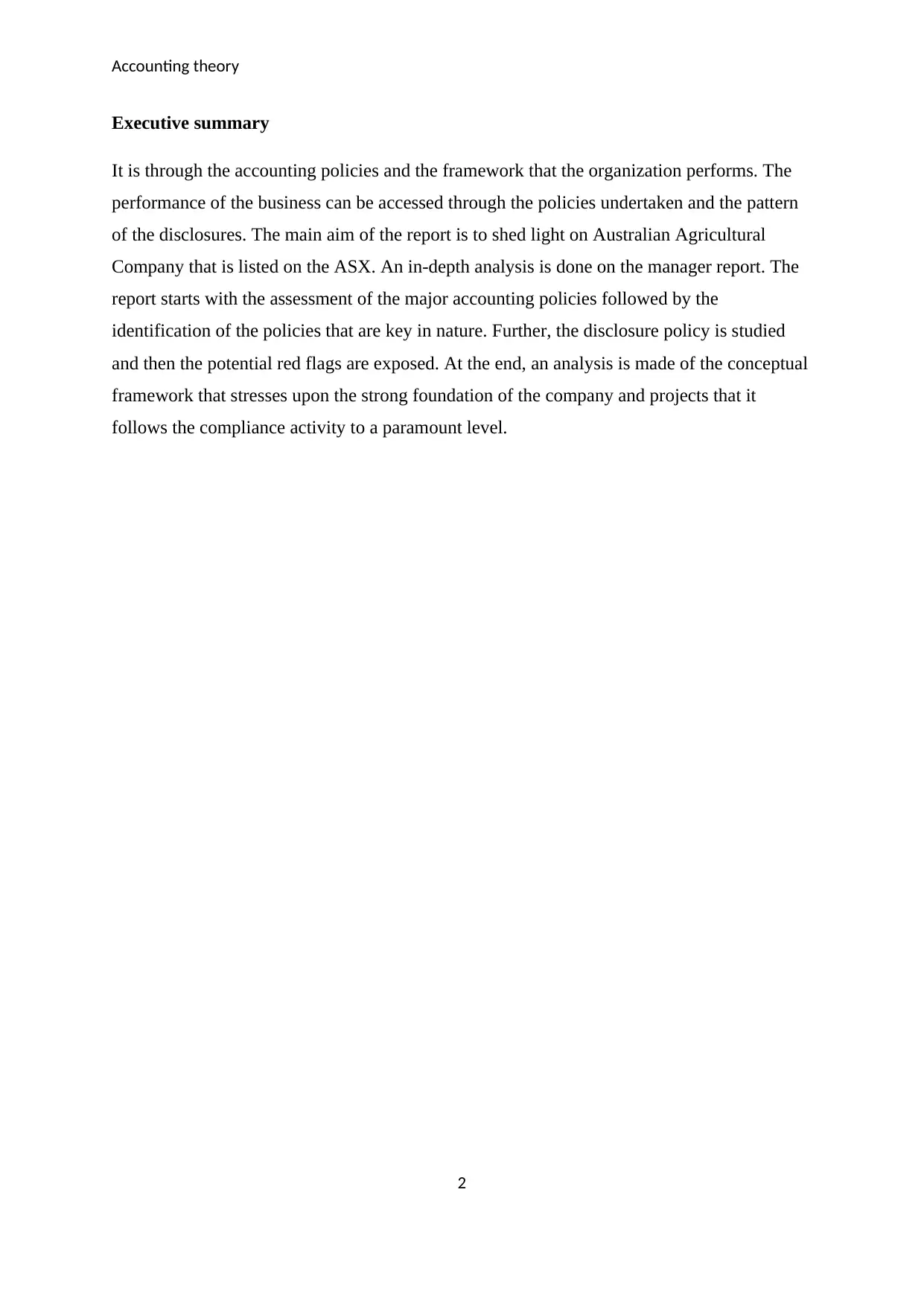
Accounting theory
Executive summary
It is through the accounting policies and the framework that the organization performs. The
performance of the business can be accessed through the policies undertaken and the pattern
of the disclosures. The main aim of the report is to shed light on Australian Agricultural
Company that is listed on the ASX. An in-depth analysis is done on the manager report. The
report starts with the assessment of the major accounting policies followed by the
identification of the policies that are key in nature. Further, the disclosure policy is studied
and then the potential red flags are exposed. At the end, an analysis is made of the conceptual
framework that stresses upon the strong foundation of the company and projects that it
follows the compliance activity to a paramount level.
2
Executive summary
It is through the accounting policies and the framework that the organization performs. The
performance of the business can be accessed through the policies undertaken and the pattern
of the disclosures. The main aim of the report is to shed light on Australian Agricultural
Company that is listed on the ASX. An in-depth analysis is done on the manager report. The
report starts with the assessment of the major accounting policies followed by the
identification of the policies that are key in nature. Further, the disclosure policy is studied
and then the potential red flags are exposed. At the end, an analysis is made of the conceptual
framework that stresses upon the strong foundation of the company and projects that it
follows the compliance activity to a paramount level.
2
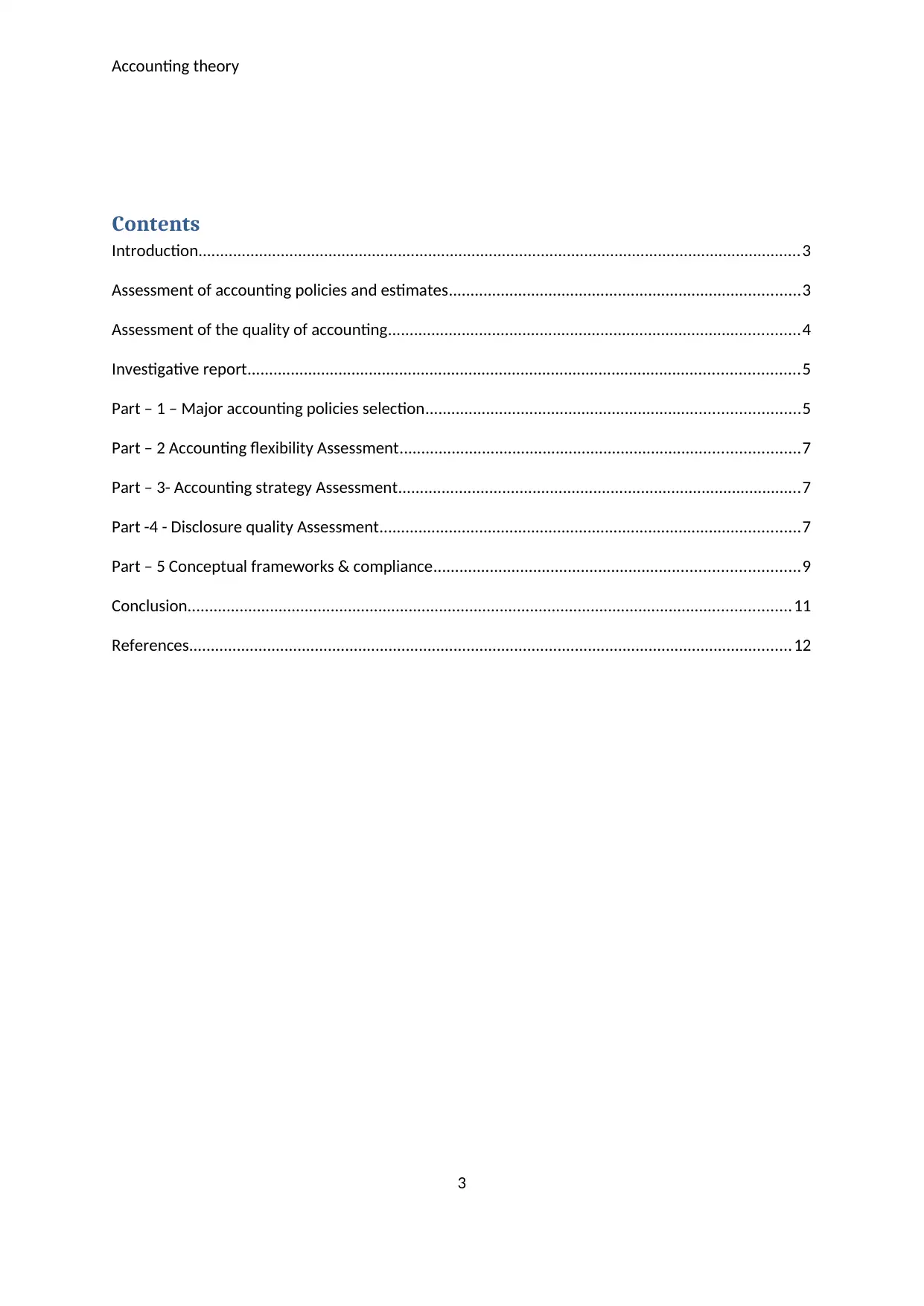
Accounting theory
Contents
Introduction...........................................................................................................................................3
Assessment of accounting policies and estimates.................................................................................3
Assessment of the quality of accounting...............................................................................................4
Investigative report...............................................................................................................................5
Part – 1 – Major accounting policies selection......................................................................................5
Part – 2 Accounting flexibility Assessment............................................................................................7
Part – 3- Accounting strategy Assessment.............................................................................................7
Part -4 - Disclosure quality Assessment.................................................................................................7
Part – 5 Conceptual frameworks & compliance....................................................................................9
Conclusion...........................................................................................................................................11
References...........................................................................................................................................12
3
Contents
Introduction...........................................................................................................................................3
Assessment of accounting policies and estimates.................................................................................3
Assessment of the quality of accounting...............................................................................................4
Investigative report...............................................................................................................................5
Part – 1 – Major accounting policies selection......................................................................................5
Part – 2 Accounting flexibility Assessment............................................................................................7
Part – 3- Accounting strategy Assessment.............................................................................................7
Part -4 - Disclosure quality Assessment.................................................................................................7
Part – 5 Conceptual frameworks & compliance....................................................................................9
Conclusion...........................................................................................................................................11
References...........................................................................................................................................12
3
⊘ This is a preview!⊘
Do you want full access?
Subscribe today to unlock all pages.

Trusted by 1+ million students worldwide
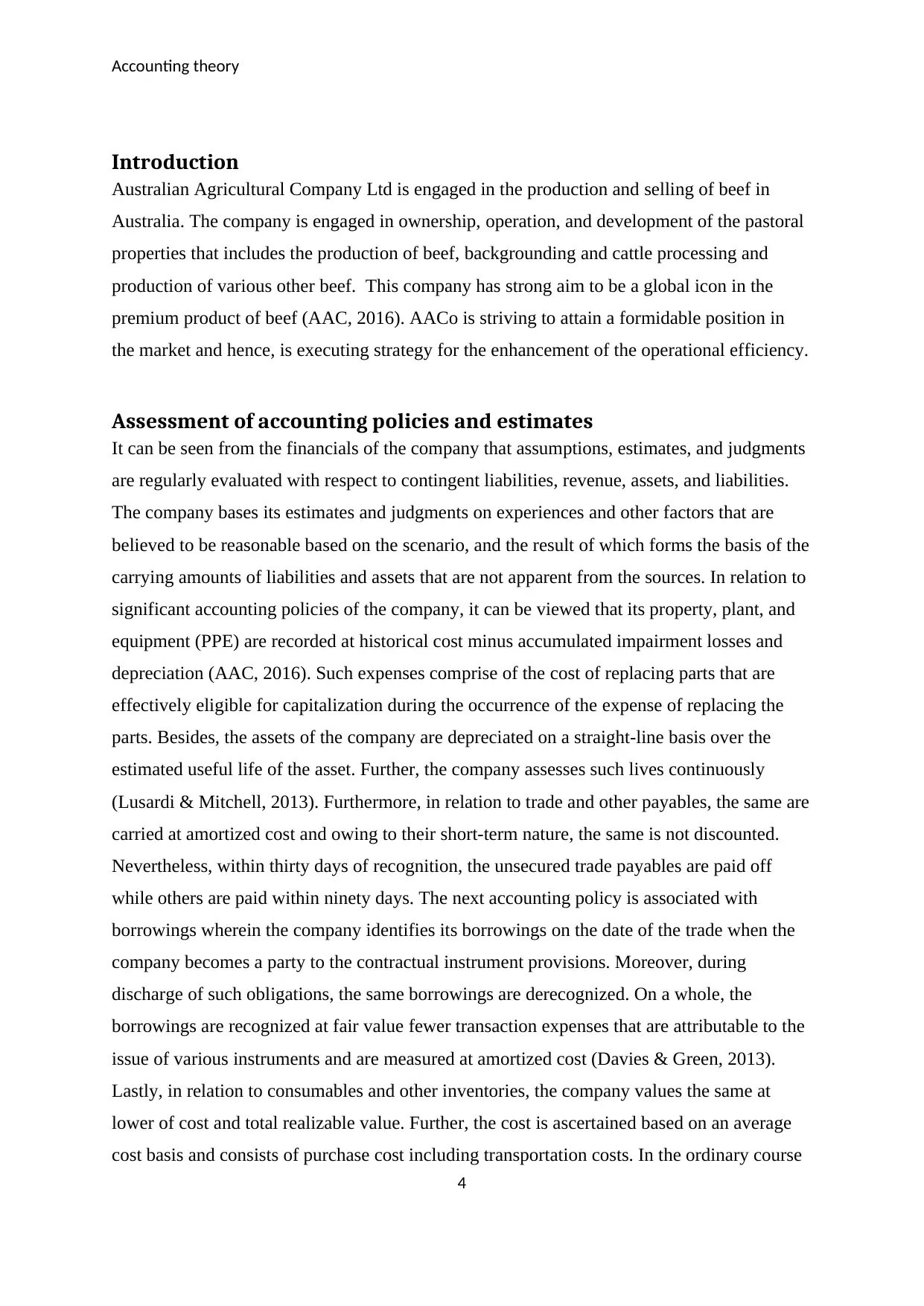
Accounting theory
Introduction
Australian Agricultural Company Ltd is engaged in the production and selling of beef in
Australia. The company is engaged in ownership, operation, and development of the pastoral
properties that includes the production of beef, backgrounding and cattle processing and
production of various other beef. This company has strong aim to be a global icon in the
premium product of beef (AAC, 2016). AACo is striving to attain a formidable position in
the market and hence, is executing strategy for the enhancement of the operational efficiency.
Assessment of accounting policies and estimates
It can be seen from the financials of the company that assumptions, estimates, and judgments
are regularly evaluated with respect to contingent liabilities, revenue, assets, and liabilities.
The company bases its estimates and judgments on experiences and other factors that are
believed to be reasonable based on the scenario, and the result of which forms the basis of the
carrying amounts of liabilities and assets that are not apparent from the sources. In relation to
significant accounting policies of the company, it can be viewed that its property, plant, and
equipment (PPE) are recorded at historical cost minus accumulated impairment losses and
depreciation (AAC, 2016). Such expenses comprise of the cost of replacing parts that are
effectively eligible for capitalization during the occurrence of the expense of replacing the
parts. Besides, the assets of the company are depreciated on a straight-line basis over the
estimated useful life of the asset. Further, the company assesses such lives continuously
(Lusardi & Mitchell, 2013). Furthermore, in relation to trade and other payables, the same are
carried at amortized cost and owing to their short-term nature, the same is not discounted.
Nevertheless, within thirty days of recognition, the unsecured trade payables are paid off
while others are paid within ninety days. The next accounting policy is associated with
borrowings wherein the company identifies its borrowings on the date of the trade when the
company becomes a party to the contractual instrument provisions. Moreover, during
discharge of such obligations, the same borrowings are derecognized. On a whole, the
borrowings are recognized at fair value fewer transaction expenses that are attributable to the
issue of various instruments and are measured at amortized cost (Davies & Green, 2013).
Lastly, in relation to consumables and other inventories, the company values the same at
lower of cost and total realizable value. Further, the cost is ascertained based on an average
cost basis and consists of purchase cost including transportation costs. In the ordinary course
4
Introduction
Australian Agricultural Company Ltd is engaged in the production and selling of beef in
Australia. The company is engaged in ownership, operation, and development of the pastoral
properties that includes the production of beef, backgrounding and cattle processing and
production of various other beef. This company has strong aim to be a global icon in the
premium product of beef (AAC, 2016). AACo is striving to attain a formidable position in
the market and hence, is executing strategy for the enhancement of the operational efficiency.
Assessment of accounting policies and estimates
It can be seen from the financials of the company that assumptions, estimates, and judgments
are regularly evaluated with respect to contingent liabilities, revenue, assets, and liabilities.
The company bases its estimates and judgments on experiences and other factors that are
believed to be reasonable based on the scenario, and the result of which forms the basis of the
carrying amounts of liabilities and assets that are not apparent from the sources. In relation to
significant accounting policies of the company, it can be viewed that its property, plant, and
equipment (PPE) are recorded at historical cost minus accumulated impairment losses and
depreciation (AAC, 2016). Such expenses comprise of the cost of replacing parts that are
effectively eligible for capitalization during the occurrence of the expense of replacing the
parts. Besides, the assets of the company are depreciated on a straight-line basis over the
estimated useful life of the asset. Further, the company assesses such lives continuously
(Lusardi & Mitchell, 2013). Furthermore, in relation to trade and other payables, the same are
carried at amortized cost and owing to their short-term nature, the same is not discounted.
Nevertheless, within thirty days of recognition, the unsecured trade payables are paid off
while others are paid within ninety days. The next accounting policy is associated with
borrowings wherein the company identifies its borrowings on the date of the trade when the
company becomes a party to the contractual instrument provisions. Moreover, during
discharge of such obligations, the same borrowings are derecognized. On a whole, the
borrowings are recognized at fair value fewer transaction expenses that are attributable to the
issue of various instruments and are measured at amortized cost (Davies & Green, 2013).
Lastly, in relation to consumables and other inventories, the company values the same at
lower of cost and total realizable value. Further, the cost is ascertained based on an average
cost basis and consists of purchase cost including transportation costs. In the ordinary course
4
Paraphrase This Document
Need a fresh take? Get an instant paraphrase of this document with our AI Paraphraser
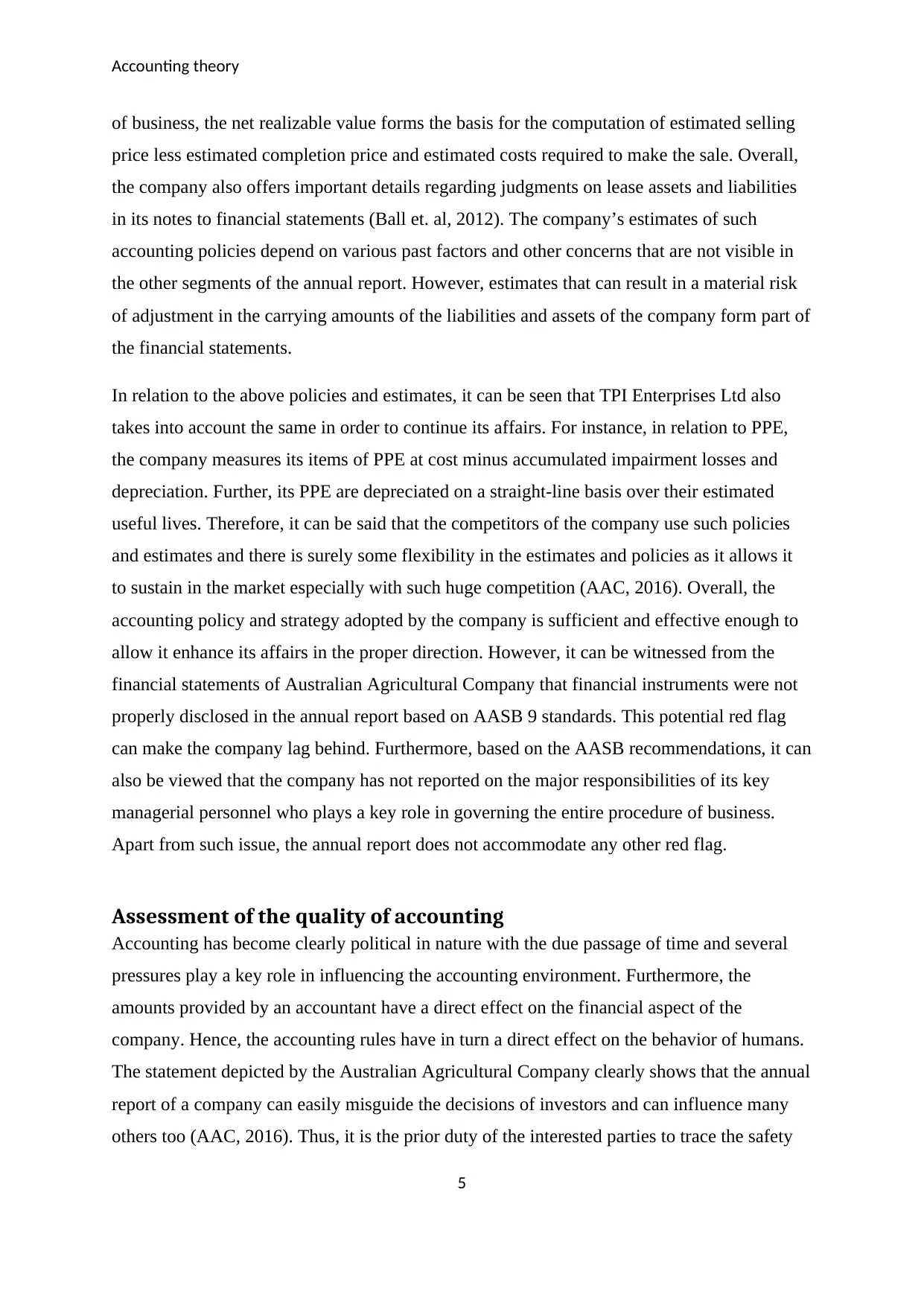
Accounting theory
of business, the net realizable value forms the basis for the computation of estimated selling
price less estimated completion price and estimated costs required to make the sale. Overall,
the company also offers important details regarding judgments on lease assets and liabilities
in its notes to financial statements (Ball et. al, 2012). The company’s estimates of such
accounting policies depend on various past factors and other concerns that are not visible in
the other segments of the annual report. However, estimates that can result in a material risk
of adjustment in the carrying amounts of the liabilities and assets of the company form part of
the financial statements.
In relation to the above policies and estimates, it can be seen that TPI Enterprises Ltd also
takes into account the same in order to continue its affairs. For instance, in relation to PPE,
the company measures its items of PPE at cost minus accumulated impairment losses and
depreciation. Further, its PPE are depreciated on a straight-line basis over their estimated
useful lives. Therefore, it can be said that the competitors of the company use such policies
and estimates and there is surely some flexibility in the estimates and policies as it allows it
to sustain in the market especially with such huge competition (AAC, 2016). Overall, the
accounting policy and strategy adopted by the company is sufficient and effective enough to
allow it enhance its affairs in the proper direction. However, it can be witnessed from the
financial statements of Australian Agricultural Company that financial instruments were not
properly disclosed in the annual report based on AASB 9 standards. This potential red flag
can make the company lag behind. Furthermore, based on the AASB recommendations, it can
also be viewed that the company has not reported on the major responsibilities of its key
managerial personnel who plays a key role in governing the entire procedure of business.
Apart from such issue, the annual report does not accommodate any other red flag.
Assessment of the quality of accounting
Accounting has become clearly political in nature with the due passage of time and several
pressures play a key role in influencing the accounting environment. Furthermore, the
amounts provided by an accountant have a direct effect on the financial aspect of the
company. Hence, the accounting rules have in turn a direct effect on the behavior of humans.
The statement depicted by the Australian Agricultural Company clearly shows that the annual
report of a company can easily misguide the decisions of investors and can influence many
others too (AAC, 2016). Thus, it is the prior duty of the interested parties to trace the safety
5
of business, the net realizable value forms the basis for the computation of estimated selling
price less estimated completion price and estimated costs required to make the sale. Overall,
the company also offers important details regarding judgments on lease assets and liabilities
in its notes to financial statements (Ball et. al, 2012). The company’s estimates of such
accounting policies depend on various past factors and other concerns that are not visible in
the other segments of the annual report. However, estimates that can result in a material risk
of adjustment in the carrying amounts of the liabilities and assets of the company form part of
the financial statements.
In relation to the above policies and estimates, it can be seen that TPI Enterprises Ltd also
takes into account the same in order to continue its affairs. For instance, in relation to PPE,
the company measures its items of PPE at cost minus accumulated impairment losses and
depreciation. Further, its PPE are depreciated on a straight-line basis over their estimated
useful lives. Therefore, it can be said that the competitors of the company use such policies
and estimates and there is surely some flexibility in the estimates and policies as it allows it
to sustain in the market especially with such huge competition (AAC, 2016). Overall, the
accounting policy and strategy adopted by the company is sufficient and effective enough to
allow it enhance its affairs in the proper direction. However, it can be witnessed from the
financial statements of Australian Agricultural Company that financial instruments were not
properly disclosed in the annual report based on AASB 9 standards. This potential red flag
can make the company lag behind. Furthermore, based on the AASB recommendations, it can
also be viewed that the company has not reported on the major responsibilities of its key
managerial personnel who plays a key role in governing the entire procedure of business.
Apart from such issue, the annual report does not accommodate any other red flag.
Assessment of the quality of accounting
Accounting has become clearly political in nature with the due passage of time and several
pressures play a key role in influencing the accounting environment. Furthermore, the
amounts provided by an accountant have a direct effect on the financial aspect of the
company. Hence, the accounting rules have in turn a direct effect on the behavior of humans.
The statement depicted by the Australian Agricultural Company clearly shows that the annual
report of a company can easily misguide the decisions of investors and can influence many
others too (AAC, 2016). Thus, it is the prior duty of the interested parties to trace the safety
5
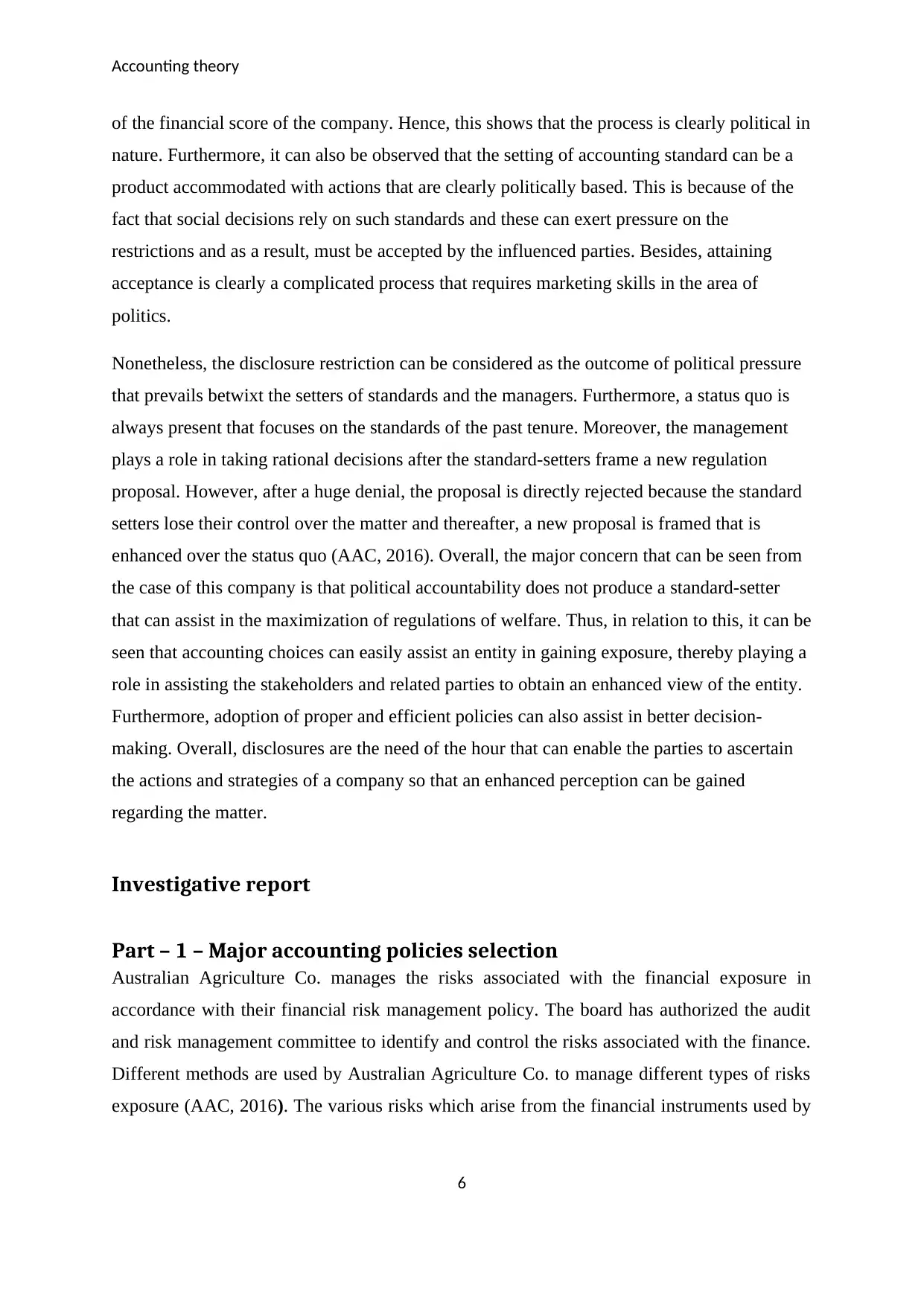
Accounting theory
of the financial score of the company. Hence, this shows that the process is clearly political in
nature. Furthermore, it can also be observed that the setting of accounting standard can be a
product accommodated with actions that are clearly politically based. This is because of the
fact that social decisions rely on such standards and these can exert pressure on the
restrictions and as a result, must be accepted by the influenced parties. Besides, attaining
acceptance is clearly a complicated process that requires marketing skills in the area of
politics.
Nonetheless, the disclosure restriction can be considered as the outcome of political pressure
that prevails betwixt the setters of standards and the managers. Furthermore, a status quo is
always present that focuses on the standards of the past tenure. Moreover, the management
plays a role in taking rational decisions after the standard-setters frame a new regulation
proposal. However, after a huge denial, the proposal is directly rejected because the standard
setters lose their control over the matter and thereafter, a new proposal is framed that is
enhanced over the status quo (AAC, 2016). Overall, the major concern that can be seen from
the case of this company is that political accountability does not produce a standard-setter
that can assist in the maximization of regulations of welfare. Thus, in relation to this, it can be
seen that accounting choices can easily assist an entity in gaining exposure, thereby playing a
role in assisting the stakeholders and related parties to obtain an enhanced view of the entity.
Furthermore, adoption of proper and efficient policies can also assist in better decision-
making. Overall, disclosures are the need of the hour that can enable the parties to ascertain
the actions and strategies of a company so that an enhanced perception can be gained
regarding the matter.
Investigative report
Part – 1 – Major accounting policies selection
Australian Agriculture Co. manages the risks associated with the financial exposure in
accordance with their financial risk management policy. The board has authorized the audit
and risk management committee to identify and control the risks associated with the finance.
Different methods are used by Australian Agriculture Co. to manage different types of risks
exposure (AAC, 2016). The various risks which arise from the financial instruments used by
6
of the financial score of the company. Hence, this shows that the process is clearly political in
nature. Furthermore, it can also be observed that the setting of accounting standard can be a
product accommodated with actions that are clearly politically based. This is because of the
fact that social decisions rely on such standards and these can exert pressure on the
restrictions and as a result, must be accepted by the influenced parties. Besides, attaining
acceptance is clearly a complicated process that requires marketing skills in the area of
politics.
Nonetheless, the disclosure restriction can be considered as the outcome of political pressure
that prevails betwixt the setters of standards and the managers. Furthermore, a status quo is
always present that focuses on the standards of the past tenure. Moreover, the management
plays a role in taking rational decisions after the standard-setters frame a new regulation
proposal. However, after a huge denial, the proposal is directly rejected because the standard
setters lose their control over the matter and thereafter, a new proposal is framed that is
enhanced over the status quo (AAC, 2016). Overall, the major concern that can be seen from
the case of this company is that political accountability does not produce a standard-setter
that can assist in the maximization of regulations of welfare. Thus, in relation to this, it can be
seen that accounting choices can easily assist an entity in gaining exposure, thereby playing a
role in assisting the stakeholders and related parties to obtain an enhanced view of the entity.
Furthermore, adoption of proper and efficient policies can also assist in better decision-
making. Overall, disclosures are the need of the hour that can enable the parties to ascertain
the actions and strategies of a company so that an enhanced perception can be gained
regarding the matter.
Investigative report
Part – 1 – Major accounting policies selection
Australian Agriculture Co. manages the risks associated with the financial exposure in
accordance with their financial risk management policy. The board has authorized the audit
and risk management committee to identify and control the risks associated with the finance.
Different methods are used by Australian Agriculture Co. to manage different types of risks
exposure (AAC, 2016). The various risks which arise from the financial instruments used by
6
⊘ This is a preview!⊘
Do you want full access?
Subscribe today to unlock all pages.

Trusted by 1+ million students worldwide
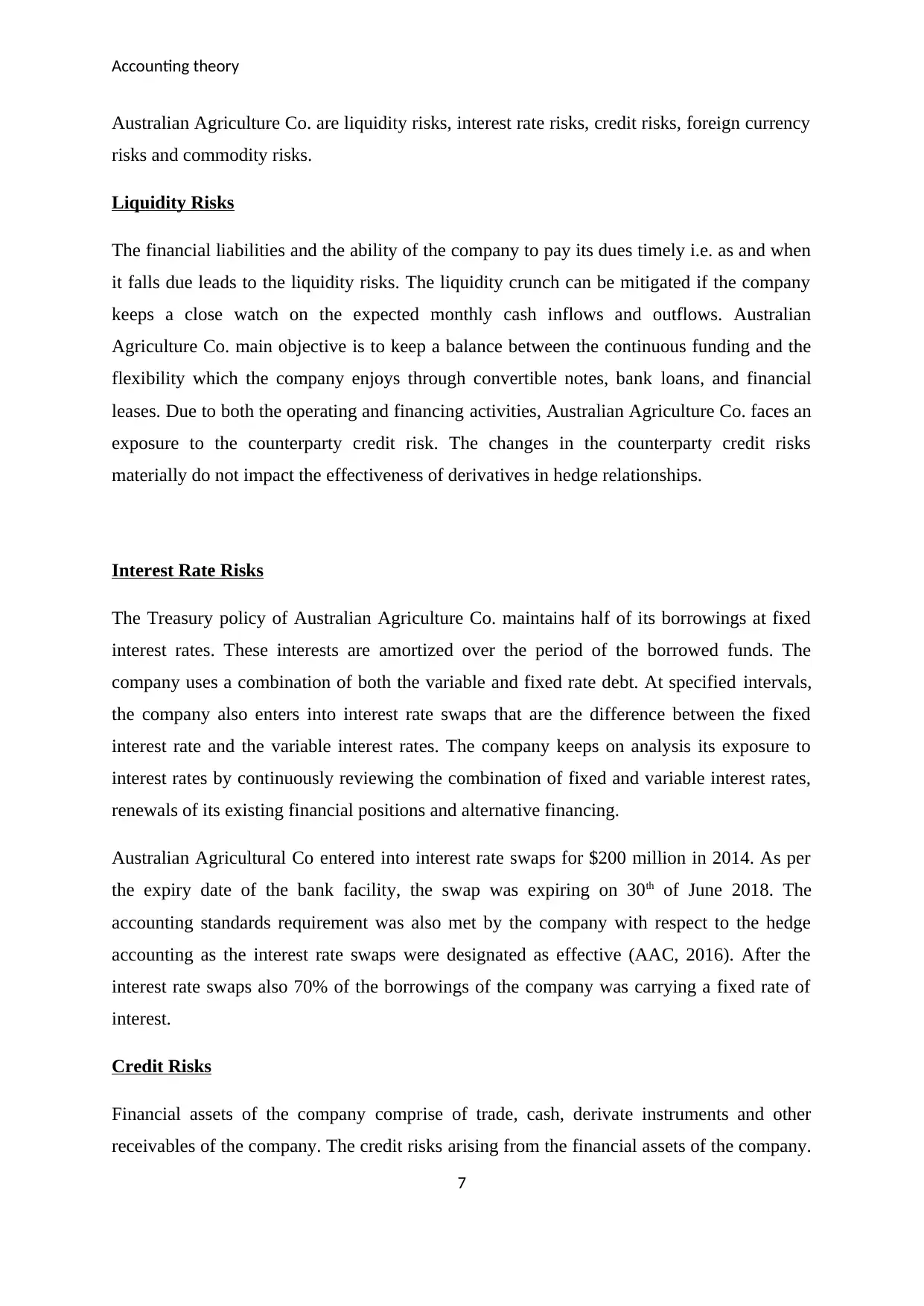
Accounting theory
Australian Agriculture Co. are liquidity risks, interest rate risks, credit risks, foreign currency
risks and commodity risks.
Liquidity Risks
The financial liabilities and the ability of the company to pay its dues timely i.e. as and when
it falls due leads to the liquidity risks. The liquidity crunch can be mitigated if the company
keeps a close watch on the expected monthly cash inflows and outflows. Australian
Agriculture Co. main objective is to keep a balance between the continuous funding and the
flexibility which the company enjoys through convertible notes, bank loans, and financial
leases. Due to both the operating and financing activities, Australian Agriculture Co. faces an
exposure to the counterparty credit risk. The changes in the counterparty credit risks
materially do not impact the effectiveness of derivatives in hedge relationships.
Interest Rate Risks
The Treasury policy of Australian Agriculture Co. maintains half of its borrowings at fixed
interest rates. These interests are amortized over the period of the borrowed funds. The
company uses a combination of both the variable and fixed rate debt. At specified intervals,
the company also enters into interest rate swaps that are the difference between the fixed
interest rate and the variable interest rates. The company keeps on analysis its exposure to
interest rates by continuously reviewing the combination of fixed and variable interest rates,
renewals of its existing financial positions and alternative financing.
Australian Agricultural Co entered into interest rate swaps for $200 million in 2014. As per
the expiry date of the bank facility, the swap was expiring on 30th of June 2018. The
accounting standards requirement was also met by the company with respect to the hedge
accounting as the interest rate swaps were designated as effective (AAC, 2016). After the
interest rate swaps also 70% of the borrowings of the company was carrying a fixed rate of
interest.
Credit Risks
Financial assets of the company comprise of trade, cash, derivate instruments and other
receivables of the company. The credit risks arising from the financial assets of the company.
7
Australian Agriculture Co. are liquidity risks, interest rate risks, credit risks, foreign currency
risks and commodity risks.
Liquidity Risks
The financial liabilities and the ability of the company to pay its dues timely i.e. as and when
it falls due leads to the liquidity risks. The liquidity crunch can be mitigated if the company
keeps a close watch on the expected monthly cash inflows and outflows. Australian
Agriculture Co. main objective is to keep a balance between the continuous funding and the
flexibility which the company enjoys through convertible notes, bank loans, and financial
leases. Due to both the operating and financing activities, Australian Agriculture Co. faces an
exposure to the counterparty credit risk. The changes in the counterparty credit risks
materially do not impact the effectiveness of derivatives in hedge relationships.
Interest Rate Risks
The Treasury policy of Australian Agriculture Co. maintains half of its borrowings at fixed
interest rates. These interests are amortized over the period of the borrowed funds. The
company uses a combination of both the variable and fixed rate debt. At specified intervals,
the company also enters into interest rate swaps that are the difference between the fixed
interest rate and the variable interest rates. The company keeps on analysis its exposure to
interest rates by continuously reviewing the combination of fixed and variable interest rates,
renewals of its existing financial positions and alternative financing.
Australian Agricultural Co entered into interest rate swaps for $200 million in 2014. As per
the expiry date of the bank facility, the swap was expiring on 30th of June 2018. The
accounting standards requirement was also met by the company with respect to the hedge
accounting as the interest rate swaps were designated as effective (AAC, 2016). After the
interest rate swaps also 70% of the borrowings of the company was carrying a fixed rate of
interest.
Credit Risks
Financial assets of the company comprise of trade, cash, derivate instruments and other
receivables of the company. The credit risks arising from the financial assets of the company.
7
Paraphrase This Document
Need a fresh take? Get an instant paraphrase of this document with our AI Paraphraser
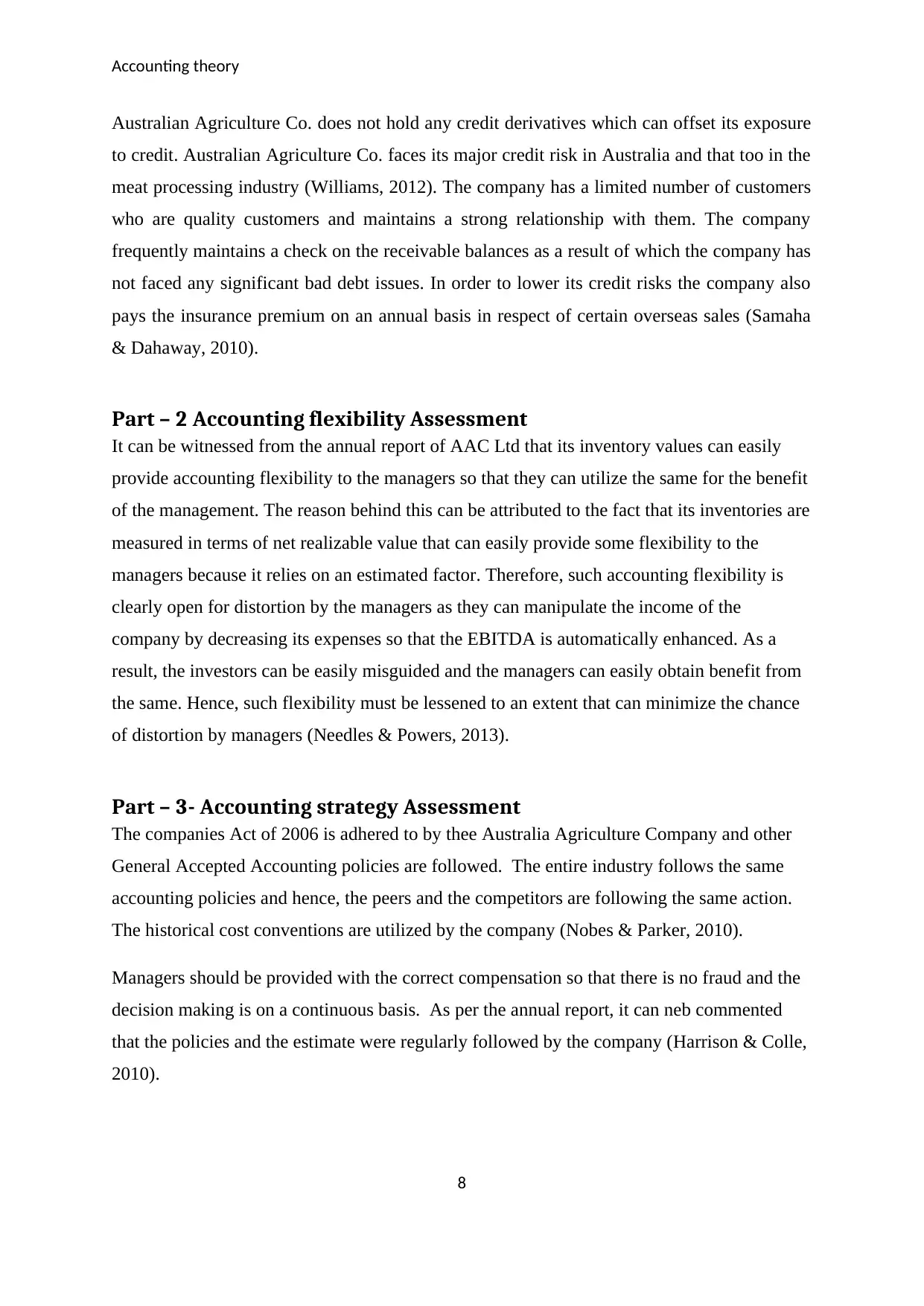
Accounting theory
Australian Agriculture Co. does not hold any credit derivatives which can offset its exposure
to credit. Australian Agriculture Co. faces its major credit risk in Australia and that too in the
meat processing industry (Williams, 2012). The company has a limited number of customers
who are quality customers and maintains a strong relationship with them. The company
frequently maintains a check on the receivable balances as a result of which the company has
not faced any significant bad debt issues. In order to lower its credit risks the company also
pays the insurance premium on an annual basis in respect of certain overseas sales (Samaha
& Dahaway, 2010).
Part – 2 Accounting flexibility Assessment
It can be witnessed from the annual report of AAC Ltd that its inventory values can easily
provide accounting flexibility to the managers so that they can utilize the same for the benefit
of the management. The reason behind this can be attributed to the fact that its inventories are
measured in terms of net realizable value that can easily provide some flexibility to the
managers because it relies on an estimated factor. Therefore, such accounting flexibility is
clearly open for distortion by the managers as they can manipulate the income of the
company by decreasing its expenses so that the EBITDA is automatically enhanced. As a
result, the investors can be easily misguided and the managers can easily obtain benefit from
the same. Hence, such flexibility must be lessened to an extent that can minimize the chance
of distortion by managers (Needles & Powers, 2013).
Part – 3- Accounting strategy Assessment
The companies Act of 2006 is adhered to by thee Australia Agriculture Company and other
General Accepted Accounting policies are followed. The entire industry follows the same
accounting policies and hence, the peers and the competitors are following the same action.
The historical cost conventions are utilized by the company (Nobes & Parker, 2010).
Managers should be provided with the correct compensation so that there is no fraud and the
decision making is on a continuous basis. As per the annual report, it can neb commented
that the policies and the estimate were regularly followed by the company (Harrison & Colle,
2010).
8
Australian Agriculture Co. does not hold any credit derivatives which can offset its exposure
to credit. Australian Agriculture Co. faces its major credit risk in Australia and that too in the
meat processing industry (Williams, 2012). The company has a limited number of customers
who are quality customers and maintains a strong relationship with them. The company
frequently maintains a check on the receivable balances as a result of which the company has
not faced any significant bad debt issues. In order to lower its credit risks the company also
pays the insurance premium on an annual basis in respect of certain overseas sales (Samaha
& Dahaway, 2010).
Part – 2 Accounting flexibility Assessment
It can be witnessed from the annual report of AAC Ltd that its inventory values can easily
provide accounting flexibility to the managers so that they can utilize the same for the benefit
of the management. The reason behind this can be attributed to the fact that its inventories are
measured in terms of net realizable value that can easily provide some flexibility to the
managers because it relies on an estimated factor. Therefore, such accounting flexibility is
clearly open for distortion by the managers as they can manipulate the income of the
company by decreasing its expenses so that the EBITDA is automatically enhanced. As a
result, the investors can be easily misguided and the managers can easily obtain benefit from
the same. Hence, such flexibility must be lessened to an extent that can minimize the chance
of distortion by managers (Needles & Powers, 2013).
Part – 3- Accounting strategy Assessment
The companies Act of 2006 is adhered to by thee Australia Agriculture Company and other
General Accepted Accounting policies are followed. The entire industry follows the same
accounting policies and hence, the peers and the competitors are following the same action.
The historical cost conventions are utilized by the company (Nobes & Parker, 2010).
Managers should be provided with the correct compensation so that there is no fraud and the
decision making is on a continuous basis. As per the annual report, it can neb commented
that the policies and the estimate were regularly followed by the company (Harrison & Colle,
2010).
8
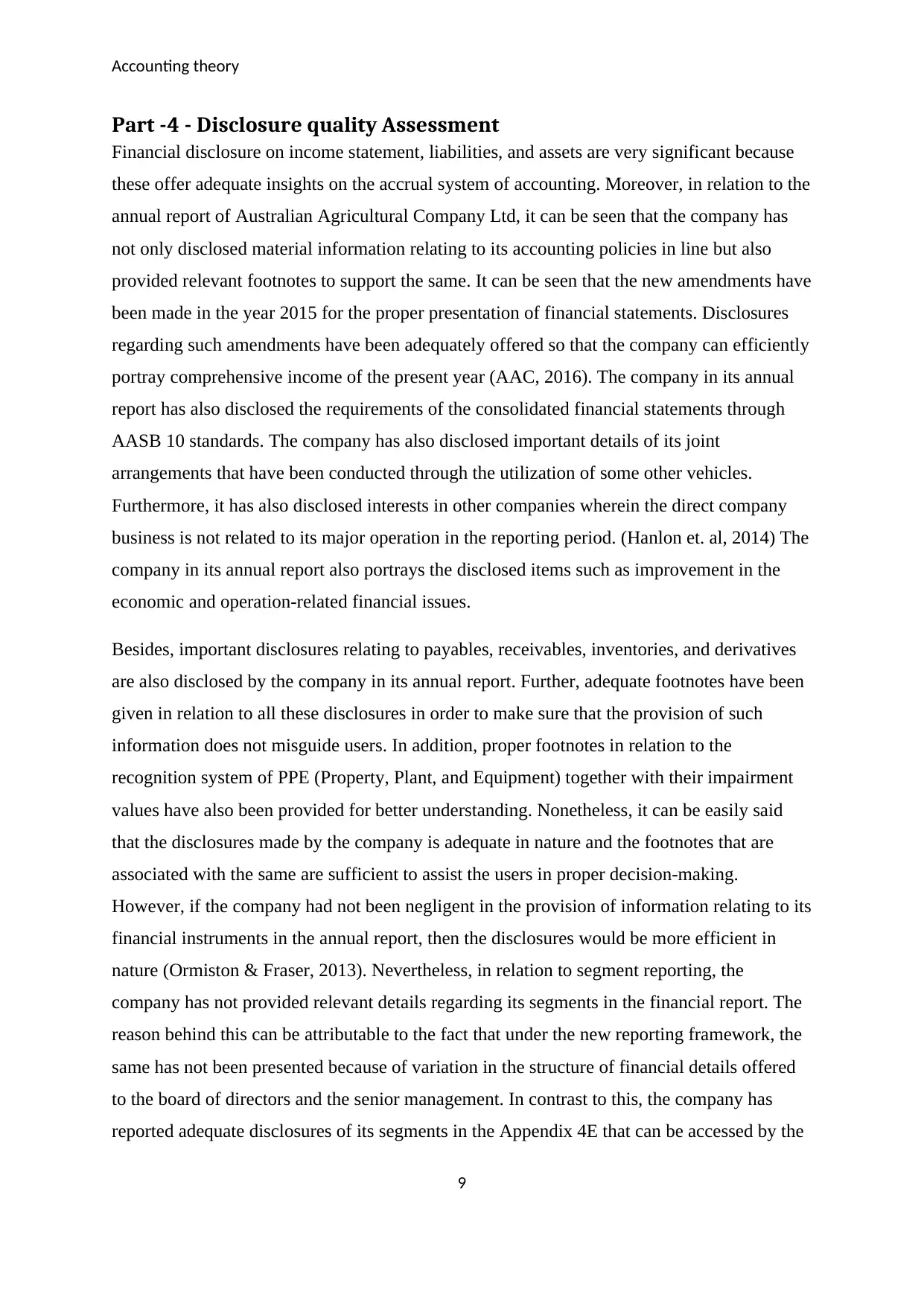
Accounting theory
Part -4 - Disclosure quality Assessment
Financial disclosure on income statement, liabilities, and assets are very significant because
these offer adequate insights on the accrual system of accounting. Moreover, in relation to the
annual report of Australian Agricultural Company Ltd, it can be seen that the company has
not only disclosed material information relating to its accounting policies in line but also
provided relevant footnotes to support the same. It can be seen that the new amendments have
been made in the year 2015 for the proper presentation of financial statements. Disclosures
regarding such amendments have been adequately offered so that the company can efficiently
portray comprehensive income of the present year (AAC, 2016). The company in its annual
report has also disclosed the requirements of the consolidated financial statements through
AASB 10 standards. The company has also disclosed important details of its joint
arrangements that have been conducted through the utilization of some other vehicles.
Furthermore, it has also disclosed interests in other companies wherein the direct company
business is not related to its major operation in the reporting period. (Hanlon et. al, 2014) The
company in its annual report also portrays the disclosed items such as improvement in the
economic and operation-related financial issues.
Besides, important disclosures relating to payables, receivables, inventories, and derivatives
are also disclosed by the company in its annual report. Further, adequate footnotes have been
given in relation to all these disclosures in order to make sure that the provision of such
information does not misguide users. In addition, proper footnotes in relation to the
recognition system of PPE (Property, Plant, and Equipment) together with their impairment
values have also been provided for better understanding. Nonetheless, it can be easily said
that the disclosures made by the company is adequate in nature and the footnotes that are
associated with the same are sufficient to assist the users in proper decision-making.
However, if the company had not been negligent in the provision of information relating to its
financial instruments in the annual report, then the disclosures would be more efficient in
nature (Ormiston & Fraser, 2013). Nevertheless, in relation to segment reporting, the
company has not provided relevant details regarding its segments in the financial report. The
reason behind this can be attributable to the fact that under the new reporting framework, the
same has not been presented because of variation in the structure of financial details offered
to the board of directors and the senior management. In contrast to this, the company has
reported adequate disclosures of its segments in the Appendix 4E that can be accessed by the
9
Part -4 - Disclosure quality Assessment
Financial disclosure on income statement, liabilities, and assets are very significant because
these offer adequate insights on the accrual system of accounting. Moreover, in relation to the
annual report of Australian Agricultural Company Ltd, it can be seen that the company has
not only disclosed material information relating to its accounting policies in line but also
provided relevant footnotes to support the same. It can be seen that the new amendments have
been made in the year 2015 for the proper presentation of financial statements. Disclosures
regarding such amendments have been adequately offered so that the company can efficiently
portray comprehensive income of the present year (AAC, 2016). The company in its annual
report has also disclosed the requirements of the consolidated financial statements through
AASB 10 standards. The company has also disclosed important details of its joint
arrangements that have been conducted through the utilization of some other vehicles.
Furthermore, it has also disclosed interests in other companies wherein the direct company
business is not related to its major operation in the reporting period. (Hanlon et. al, 2014) The
company in its annual report also portrays the disclosed items such as improvement in the
economic and operation-related financial issues.
Besides, important disclosures relating to payables, receivables, inventories, and derivatives
are also disclosed by the company in its annual report. Further, adequate footnotes have been
given in relation to all these disclosures in order to make sure that the provision of such
information does not misguide users. In addition, proper footnotes in relation to the
recognition system of PPE (Property, Plant, and Equipment) together with their impairment
values have also been provided for better understanding. Nonetheless, it can be easily said
that the disclosures made by the company is adequate in nature and the footnotes that are
associated with the same are sufficient to assist the users in proper decision-making.
However, if the company had not been negligent in the provision of information relating to its
financial instruments in the annual report, then the disclosures would be more efficient in
nature (Ormiston & Fraser, 2013). Nevertheless, in relation to segment reporting, the
company has not provided relevant details regarding its segments in the financial report. The
reason behind this can be attributable to the fact that under the new reporting framework, the
same has not been presented because of variation in the structure of financial details offered
to the board of directors and the senior management. In contrast to this, the company has
reported adequate disclosures of its segments in the Appendix 4E that can be accessed by the
9
⊘ This is a preview!⊘
Do you want full access?
Subscribe today to unlock all pages.

Trusted by 1+ million students worldwide
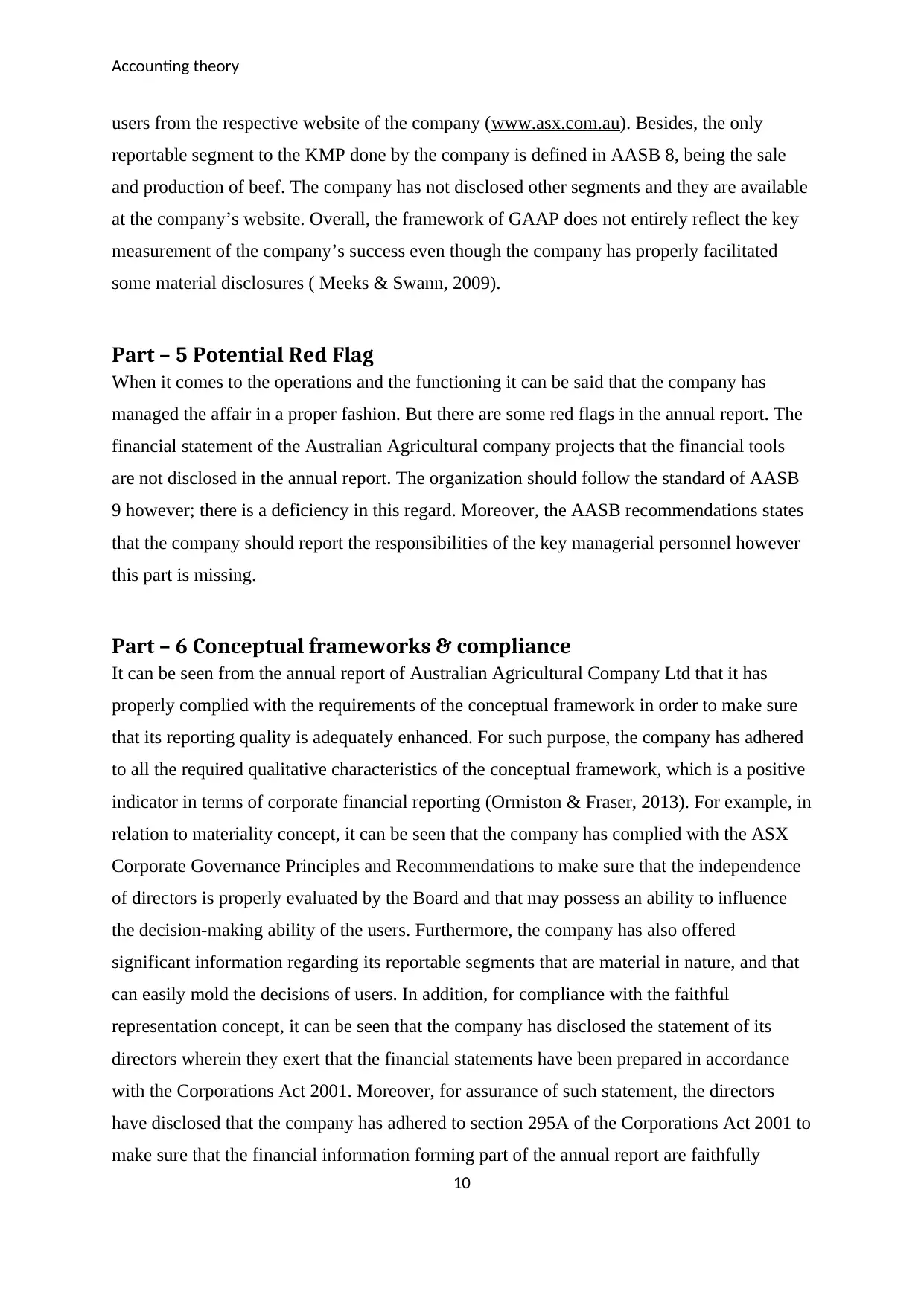
Accounting theory
users from the respective website of the company (www.asx.com.au). Besides, the only
reportable segment to the KMP done by the company is defined in AASB 8, being the sale
and production of beef. The company has not disclosed other segments and they are available
at the company’s website. Overall, the framework of GAAP does not entirely reflect the key
measurement of the company’s success even though the company has properly facilitated
some material disclosures ( Meeks & Swann, 2009).
Part – 5 Potential Red Flag
When it comes to the operations and the functioning it can be said that the company has
managed the affair in a proper fashion. But there are some red flags in the annual report. The
financial statement of the Australian Agricultural company projects that the financial tools
are not disclosed in the annual report. The organization should follow the standard of AASB
9 however; there is a deficiency in this regard. Moreover, the AASB recommendations states
that the company should report the responsibilities of the key managerial personnel however
this part is missing.
Part – 6 Conceptual frameworks & compliance
It can be seen from the annual report of Australian Agricultural Company Ltd that it has
properly complied with the requirements of the conceptual framework in order to make sure
that its reporting quality is adequately enhanced. For such purpose, the company has adhered
to all the required qualitative characteristics of the conceptual framework, which is a positive
indicator in terms of corporate financial reporting (Ormiston & Fraser, 2013). For example, in
relation to materiality concept, it can be seen that the company has complied with the ASX
Corporate Governance Principles and Recommendations to make sure that the independence
of directors is properly evaluated by the Board and that may possess an ability to influence
the decision-making ability of the users. Furthermore, the company has also offered
significant information regarding its reportable segments that are material in nature, and that
can easily mold the decisions of users. In addition, for compliance with the faithful
representation concept, it can be seen that the company has disclosed the statement of its
directors wherein they exert that the financial statements have been prepared in accordance
with the Corporations Act 2001. Moreover, for assurance of such statement, the directors
have disclosed that the company has adhered to section 295A of the Corporations Act 2001 to
make sure that the financial information forming part of the annual report are faithfully
10
users from the respective website of the company (www.asx.com.au). Besides, the only
reportable segment to the KMP done by the company is defined in AASB 8, being the sale
and production of beef. The company has not disclosed other segments and they are available
at the company’s website. Overall, the framework of GAAP does not entirely reflect the key
measurement of the company’s success even though the company has properly facilitated
some material disclosures ( Meeks & Swann, 2009).
Part – 5 Potential Red Flag
When it comes to the operations and the functioning it can be said that the company has
managed the affair in a proper fashion. But there are some red flags in the annual report. The
financial statement of the Australian Agricultural company projects that the financial tools
are not disclosed in the annual report. The organization should follow the standard of AASB
9 however; there is a deficiency in this regard. Moreover, the AASB recommendations states
that the company should report the responsibilities of the key managerial personnel however
this part is missing.
Part – 6 Conceptual frameworks & compliance
It can be seen from the annual report of Australian Agricultural Company Ltd that it has
properly complied with the requirements of the conceptual framework in order to make sure
that its reporting quality is adequately enhanced. For such purpose, the company has adhered
to all the required qualitative characteristics of the conceptual framework, which is a positive
indicator in terms of corporate financial reporting (Ormiston & Fraser, 2013). For example, in
relation to materiality concept, it can be seen that the company has complied with the ASX
Corporate Governance Principles and Recommendations to make sure that the independence
of directors is properly evaluated by the Board and that may possess an ability to influence
the decision-making ability of the users. Furthermore, the company has also offered
significant information regarding its reportable segments that are material in nature, and that
can easily mold the decisions of users. In addition, for compliance with the faithful
representation concept, it can be seen that the company has disclosed the statement of its
directors wherein they exert that the financial statements have been prepared in accordance
with the Corporations Act 2001. Moreover, for assurance of such statement, the directors
have disclosed that the company has adhered to section 295A of the Corporations Act 2001 to
make sure that the financial information forming part of the annual report are faithfully
10
Paraphrase This Document
Need a fresh take? Get an instant paraphrase of this document with our AI Paraphraser
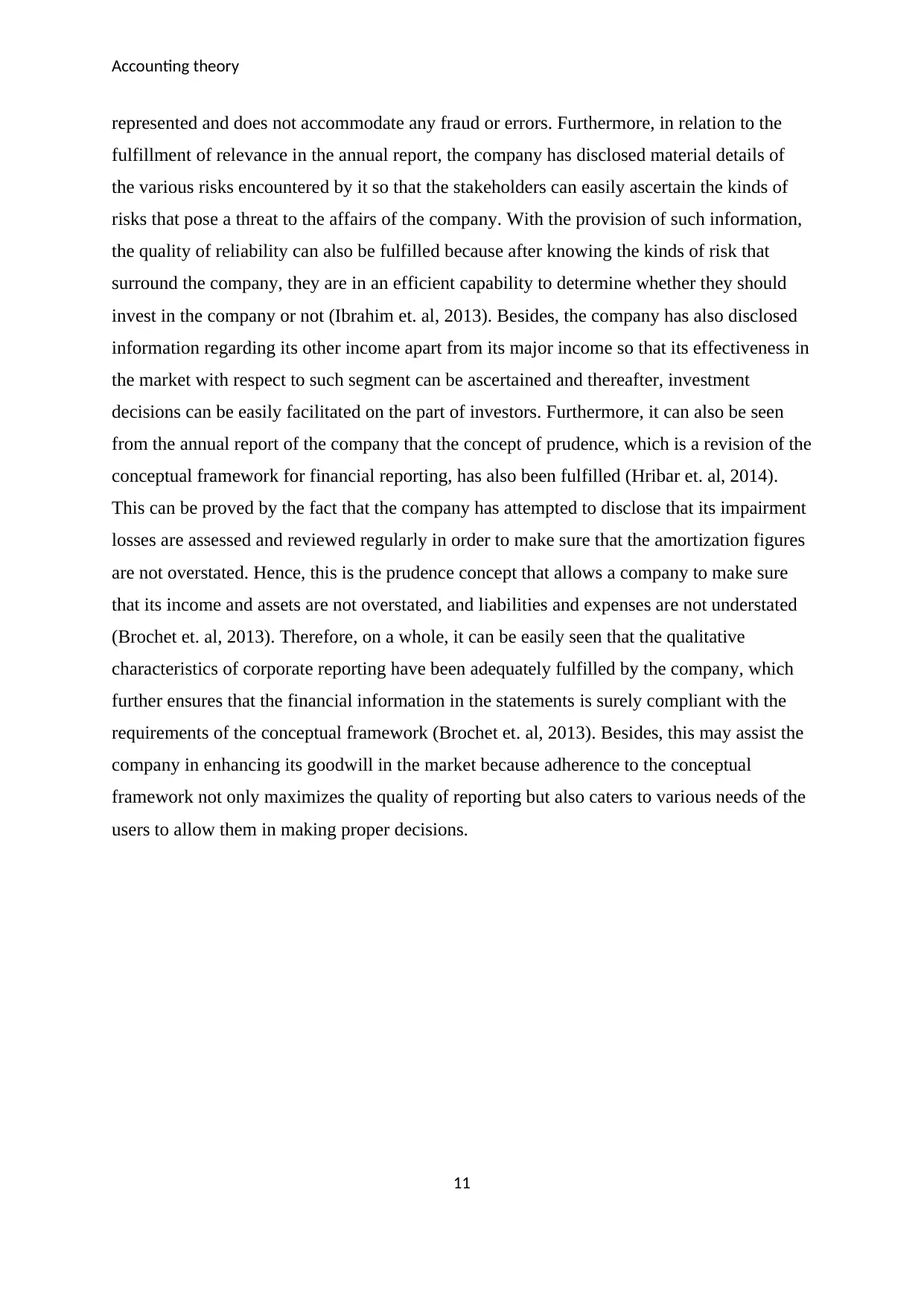
Accounting theory
represented and does not accommodate any fraud or errors. Furthermore, in relation to the
fulfillment of relevance in the annual report, the company has disclosed material details of
the various risks encountered by it so that the stakeholders can easily ascertain the kinds of
risks that pose a threat to the affairs of the company. With the provision of such information,
the quality of reliability can also be fulfilled because after knowing the kinds of risk that
surround the company, they are in an efficient capability to determine whether they should
invest in the company or not (Ibrahim et. al, 2013). Besides, the company has also disclosed
information regarding its other income apart from its major income so that its effectiveness in
the market with respect to such segment can be ascertained and thereafter, investment
decisions can be easily facilitated on the part of investors. Furthermore, it can also be seen
from the annual report of the company that the concept of prudence, which is a revision of the
conceptual framework for financial reporting, has also been fulfilled (Hribar et. al, 2014).
This can be proved by the fact that the company has attempted to disclose that its impairment
losses are assessed and reviewed regularly in order to make sure that the amortization figures
are not overstated. Hence, this is the prudence concept that allows a company to make sure
that its income and assets are not overstated, and liabilities and expenses are not understated
(Brochet et. al, 2013). Therefore, on a whole, it can be easily seen that the qualitative
characteristics of corporate reporting have been adequately fulfilled by the company, which
further ensures that the financial information in the statements is surely compliant with the
requirements of the conceptual framework (Brochet et. al, 2013). Besides, this may assist the
company in enhancing its goodwill in the market because adherence to the conceptual
framework not only maximizes the quality of reporting but also caters to various needs of the
users to allow them in making proper decisions.
11
represented and does not accommodate any fraud or errors. Furthermore, in relation to the
fulfillment of relevance in the annual report, the company has disclosed material details of
the various risks encountered by it so that the stakeholders can easily ascertain the kinds of
risks that pose a threat to the affairs of the company. With the provision of such information,
the quality of reliability can also be fulfilled because after knowing the kinds of risk that
surround the company, they are in an efficient capability to determine whether they should
invest in the company or not (Ibrahim et. al, 2013). Besides, the company has also disclosed
information regarding its other income apart from its major income so that its effectiveness in
the market with respect to such segment can be ascertained and thereafter, investment
decisions can be easily facilitated on the part of investors. Furthermore, it can also be seen
from the annual report of the company that the concept of prudence, which is a revision of the
conceptual framework for financial reporting, has also been fulfilled (Hribar et. al, 2014).
This can be proved by the fact that the company has attempted to disclose that its impairment
losses are assessed and reviewed regularly in order to make sure that the amortization figures
are not overstated. Hence, this is the prudence concept that allows a company to make sure
that its income and assets are not overstated, and liabilities and expenses are not understated
(Brochet et. al, 2013). Therefore, on a whole, it can be easily seen that the qualitative
characteristics of corporate reporting have been adequately fulfilled by the company, which
further ensures that the financial information in the statements is surely compliant with the
requirements of the conceptual framework (Brochet et. al, 2013). Besides, this may assist the
company in enhancing its goodwill in the market because adherence to the conceptual
framework not only maximizes the quality of reporting but also caters to various needs of the
users to allow them in making proper decisions.
11
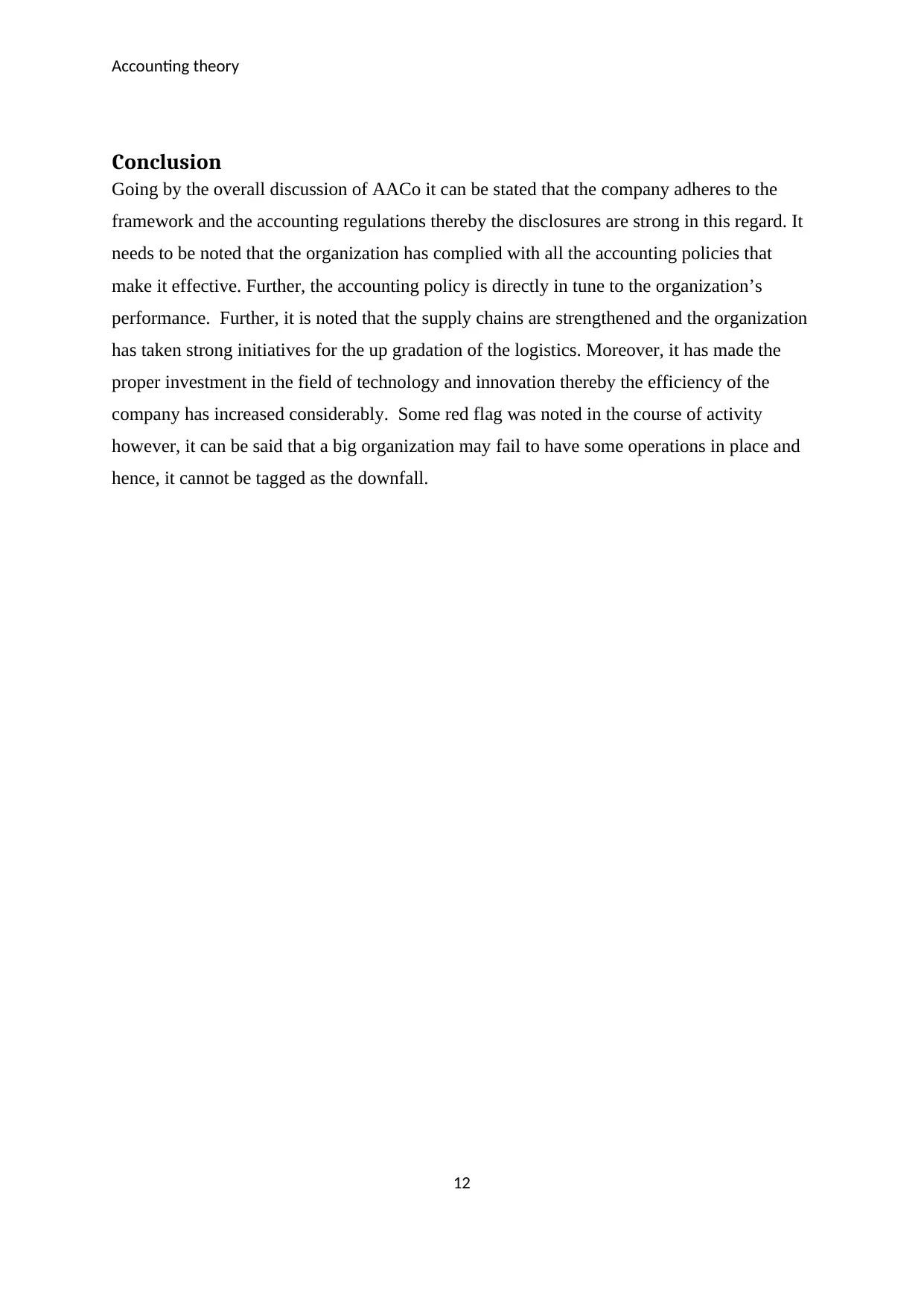
Accounting theory
Conclusion
Going by the overall discussion of AACo it can be stated that the company adheres to the
framework and the accounting regulations thereby the disclosures are strong in this regard. It
needs to be noted that the organization has complied with all the accounting policies that
make it effective. Further, the accounting policy is directly in tune to the organization’s
performance. Further, it is noted that the supply chains are strengthened and the organization
has taken strong initiatives for the up gradation of the logistics. Moreover, it has made the
proper investment in the field of technology and innovation thereby the efficiency of the
company has increased considerably. Some red flag was noted in the course of activity
however, it can be said that a big organization may fail to have some operations in place and
hence, it cannot be tagged as the downfall.
12
Conclusion
Going by the overall discussion of AACo it can be stated that the company adheres to the
framework and the accounting regulations thereby the disclosures are strong in this regard. It
needs to be noted that the organization has complied with all the accounting policies that
make it effective. Further, the accounting policy is directly in tune to the organization’s
performance. Further, it is noted that the supply chains are strengthened and the organization
has taken strong initiatives for the up gradation of the logistics. Moreover, it has made the
proper investment in the field of technology and innovation thereby the efficiency of the
company has increased considerably. Some red flag was noted in the course of activity
however, it can be said that a big organization may fail to have some operations in place and
hence, it cannot be tagged as the downfall.
12
⊘ This is a preview!⊘
Do you want full access?
Subscribe today to unlock all pages.

Trusted by 1+ million students worldwide
1 out of 14
Related Documents
Your All-in-One AI-Powered Toolkit for Academic Success.
+13062052269
info@desklib.com
Available 24*7 on WhatsApp / Email
![[object Object]](/_next/static/media/star-bottom.7253800d.svg)
Unlock your academic potential
Copyright © 2020–2025 A2Z Services. All Rights Reserved. Developed and managed by ZUCOL.




